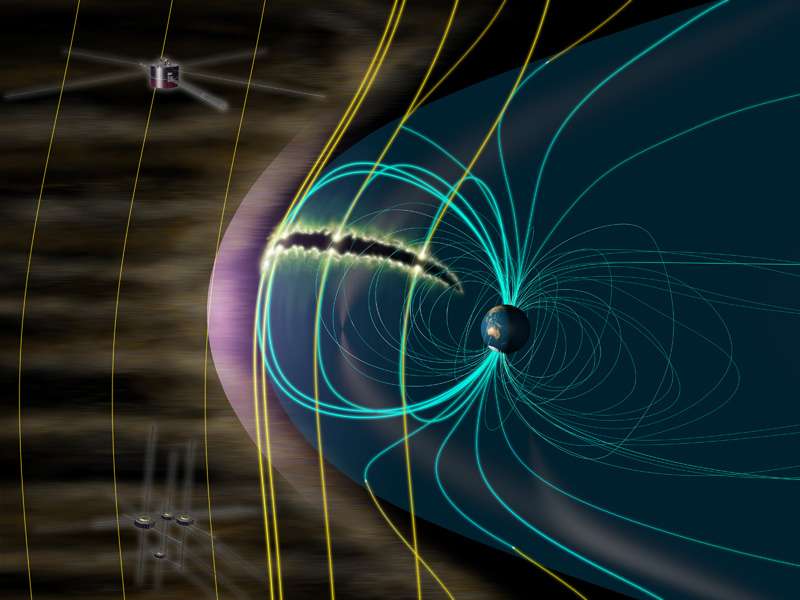The magnetosphere has a large intake of solar wind energy

Solar wind forms the energy source for aurora explosions. How does the Earth's magnetosphere take in the energy of the solar wind? An international team led by Hiroshi Hasegawa and Naritoshi Kitamura (ISAS/JAXA) analyzed data taken by the US-Japan collaborative mission GEOTAIL and NASA's MMS satellites and revealed that the interaction between the magnetic fields of Earth and the Sun, or more precisely the phenomenon known as magnetic reconnection, can feed the aurora explosions.
Artist concept of the GEOTAIL and the MMS missions to study how does the Earth's magnetosphere take in the energy of the solar wind. (Credits: ISAS/JAXA)
The region of outer space near Earth, also called geospace, is not a peaceful region. For example, solar wind, a fast flow of charged particles driven by the Sun's magnetic field that blows against the Earth, is harmful for lives on the Earth. Fortunately, our planet has a shield. The Earth's magnetosphere provides an invisible protection from the solar wind.
The interaction between the solar wind and Earth's magnetosphere can cause various phenomena, such as aurora.
According to the prevailing theory, an aurora explosion involves four main processes:
(1) The energy of the solar wind enters the Earth's magnetosphere,
(2) The tail of the magnetosphere stores the energy,
(3) The stored energy is released quickly and transferred to the plasma particles,
(4) These plasma particles move toward the Earth's polar region along magnetic field lines, and finally cause an aurora explosion.
Magnetic reconnection is believed to be the key mechanism involved in the entry (1) and release (3) of the energy of the solar wind.
Using data from the GEOTAIL and MMS missions, the international team led by Hiroshi Hasegawa and Naritoshi Kitamura (ISAS/JAXA) studied the first of the four processes mentioned above. The data was collected in October and November 2015. On one day, GEOTAIL and MMS both detected plasma jets produced by magnetic reconnection lasting over a period of 5 hours.
The team first focused on detecting the disappearance of magnetic ropes. When the magnetic reconnection process occurs at multiple sites, magnetic ropes composed of twisted magnetic field lines are produced. It was commonly believed that magnetic ropes become larger when swept away by the plasma jets. However, this study revealed that magnetic ropes sometimes disappear. This means that the energy of the solar wind does not necessarily enter the magnetosphere even when magnetic reconnection occurs. In other words, this implies that magnetic ropes can prevent the entry of the solar wind energy.
This study also showed that magnetic reconnection continues over a period of at least 5 hours. Considering the orbits of the satellites together, the team estimated that the magnetic reconnection line extends over a distance of about 70,000 km.
Combining these results, the team concluded that the magnetic reconnection process is sufficient for taking in the energy of the solar wind and inducing aurora explosions.
Furthermore, this study revealed that the magnetic reconnection line shifts to the winter hemisphere side. A previous study pointed out that a shift may result in a decline in the efficiency of the energy intake from the solar wind. Also, aurora activities are known to decrease during the summer and winter seasons. Therefore, the shift of the magnetic reconnection line may be related with the seasonal variations of the auroral activities.
In this context, JAXA plans to launch a new spacecraft called the ERG satellite that aims to observe the inner region of the magnetosphere. Collaborative observations with GEOTAIL and ERG satellites will help to understand phenomena taking place in the geospace.
More information: H. Hasegawa et al. Decay of mesoscale flux transfer events during quasi-continuous spatially extended reconnection at the magnetopause, Geophysical Research Letters (2016). DOI: 10.1002/2016GL069225
N. Kitamura et al. Shift of the magnetopause reconnection line to the winter hemisphere under southward IMF conditions: Geotail and MMS observations, Geophysical Research Letters (2016). DOI: 10.1002/2016GL069095
Journal information: Geophysical Research Letters
Provided by JAXA




















